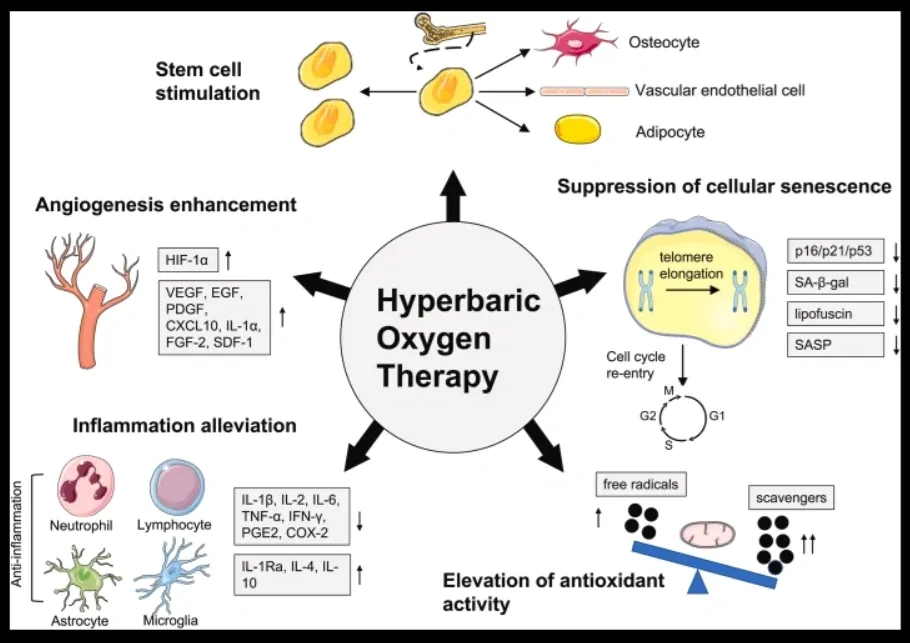
The mechanisms by which HBOT promotes healthy aging
HBOT can cause a wide range of cellular, biochemical and physiological changes. The proven biological mechanisms by which HBOT may promote healthy aging can be summarized into five categories:
(1) Stem cells are the body’s raw materials — cells from which all other cells with specialized functions are generated. Stem cell therapy, also known as regenerative medicine, promotes the repair response of diseased, dysfunctional or injured tissue using stem cells or their derivatives. HBOT increases the number of circulating stem cells by stimulating stem cell mobilization, and changes stem cell properties by promoting proliferation and differentiation.
(2) HBOT reduces inflammation by regulating the number and activity of extensive inflammatory cell types such as neutrophils, lymphocytes, astrocytes and microglia. At the molecular level, HBOT can inhibit pro-inflammatory factors while promoting anti-inflammatory factors.
(3) Free radicals produced in the mitochondria damage the substances that the cell needs to work properly. This damage causes mutations that produce more free radicals, thus accelerating the process of damage to the cell and increasing the aging process. HBOT enhances antioxidant defenses by modulating the balance between free radicals and scavengers. The process is closely correlated with the regulation of mitochondrial function.
(4) Cellular senescence is a phenomenon characterized by the cessation of cell division, creating so-called “zombie cells” that stop dividing but continue to produce proteins that have been shown to contribute to inflammation. HBOT interferes with the detrimental effects of cellular senescence, manifested by cell cycle re-entry and attenuation of senescence markers such as p16/p21/p53, SA-β-gal, lipofuscin and the SASP. HBOT also plays a role in inhibiting telomere shortening, one of the major stimuli of cellular senescence.
(5) Angiogenesis is the formation of new blood vessels. This process involves the migration, growth, and differentiation of endothelial cells, which line the inside wall of blood vessels. The process of angiogenesis is controlled by chemical signals in the body. HBOT enhances angiogenesis mainly by increasing the expression of HIF-1α and a series of angiogenic markers.
At Journey Wellness Center we know it’s important to approach HBOT as part of a comprehensive treatment plan under the guidance of healthcare professionals experienced in treating a variety of conditions and HBOT. We practice hands on care and treatment and seek to integrate our understanding of HBOT’s role in autoimmune disease management.
Visit JourneyNapa.com today to schedule a consultation with our Certified Hyperbaric Oxygen Therapy Professionals. Ask about our New Patient Special!
